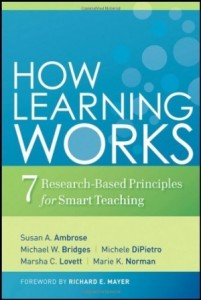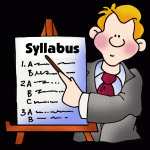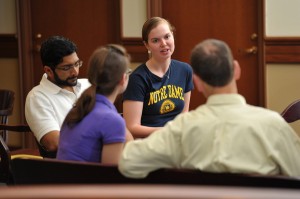The following entry from the 2012-2013 Teaching Issues Writing Consortium: Teaching Tips was contributed by Kathy Watson, Ph.D., Associate Dean for Faculty Development at Eckerd College. Dr. Watson chose to highlight important excerpts pertainting to effective feedback methods from Ambrose, S. A., et al. (2010). How Learning Works: Seven Research-Based Principles for Smart Teaching. San Francisco, CA: Jossey-Bass. This resource is available through the Kaneb Center Library.
*****
Timely and explicit feedback is an important component of the learning process. Below is an excerpt on strategies for giving effective feedback from How Learning Works: Seven Research-Based Principles for Smart Teaching (pp. 139-152).
*****
Research has long shown that feedback is more effective when it identifies particular aspects of student performance they need to improve rather than providing a generic evaluation of performance, such as a grade or abstract praise or discouragement. Although grades and scores provide some information on the degree to which students’ performance has met the criteria, they do not explain which aspects did or did not meet the criteria and how (pp. 139-140).
Simply giving students lots of feedback about their performance is also not necessarily an example of effective feedback. Too much feedback tends to overwhelm students. For example, research has shown that too many comments in the form of margin notes on student writing are often counterproductive because students are either overwhelmed by the number of items to consider or because they focus their revision on a subset of the comments that involve detailed, easy-to-fix elements rather than more important conceptual or structural changes (p. 140).
The full benefits of feedback can only be realized when the feedback adequately directs students’ subsequent practice and when students have the capacity to incorporate that feedback into further practice (p. 141).
It is also important to consider the appropriate timing of feedback. This involves both how soon feedback is given (typically, earlier is better) as well as how often (typically, more frequently is better). The ideal timing of feedback, however, cannot be determined by any general rule. Rather, it is best decided in terms of what would best support the goals you have set for students’ learning. Generally, more frequent feedback leads to more efficient learning because it helps students stay on track and address their errors before they become entrenched (p. 142).
WHAT STRATEGIES DOES THE RESEARCH SUGGEST?
Use a rubric to specify and communicate performance criteria. When students do not know what the performance criteria are, it is difficult for them to practice appropriately and to monitor their progress and understanding. A common approach to communicating performance criteria is through a rubric— a scoring tool that explicitly represents the performance expectations for a given assignment. A rubric divides the assigned work into component parts and provides clear descriptions of the characteristics of high-, medium-, and low-quality work associated with each component (p. 146).
Build in multiple opportunities for practice. Because learning accumulates gradually with practice, multiple assignments of shorter length or smaller scope tend to result in more learning than a single assignment of great length or large scope. Bear in mind, however, that a single opportunity to practice a given kind of assignment is likely to be insufficient for students to develop the relevant set of skills, let alone to be able to incorporate your feedback on subsequent, related assignments (p. 146).
Set expectations about practice. Students can underestimate the amount of time an assignment requires. It is vital to provide students with guidelines for the amount, type, and level of practice required to master the knowledge or skills at the level you expect (p.147).
Give examples or models of target performance. It can also be helpful to show students examples of what the target performance looks like (such as an effective paper or a robust solution to a problem). Sharing samples of past student work can help students see how your performance criteria can be put into practice in an actual assignment. Such examples are even more powerful when you either highlight or annotate particular features of the sample assignment that ‘work’ (p. 147).
Show students what you do not want. Illustrate common misinterpretations students have shown in the past or explain why some pieces of work do not meet your assignment goals. Such examples can also be used to give students practice at distinguishing between high- and low-quality work. To get students more actively involved and check their understanding, you can ask them to grade a sample assignment by following a rubric (p. 148).
Provide feedback at the group level. Not all feedback has to be individual to be valuable. You might at times identify the most common errors that students committed, provide the group with this list, and discuss those errors (p. 150).
Incorporate peer feedback. Not all feedback has to come from you to be valuable. With explicit guidelines, criteria, or a rubric, students can provide constructive feedback on each other’s work. This can also help students become better at identifying the qualities of good work and diagnosing their own problems. Besides the advantages to students, peer feedback allows you to increase the frequency of feedback without increasing your load. Keep in mind, however, that for peer feedback to be effective, you need to explain clearly what it is, the rationale behind it, how students would engage in it, and give students adequate practice with feedback (p. 151).
Require students to specify how they used feedback in subsequent work. Feedback is most valuable when students have the opportunity to reflect on it so they can effectively incorporate it into future practice, performance, or both. Because students often do not see the connection between or among assignments, projects, exams, and so on, asking students to note explicitly how a piece of feedback impacted their practice or performance helps them see and experience the ‘complete’ learning cycle. For example, some instructors who assign multiple drafts of papers require students to submit with each subsequent draft their commented-on prior draft with a paragraph describing how they incorporated the feedback. An analogous approach could be applied to a project assignment that included multiple milestones (pp. 151-152).
Source from which this material is excerpted: Ambrose, S. A., et al. (2010). How Learning Works: Seven Research-Based Principles for Smart Teaching. San Francisco, CA: Jossey-Bass.
Submitted by:
Kathy Watson
Associate Dean, Faculty Development
Eckerd College



 I am an avid amateur genealogist – not surprising for someone who loves puzzles. I began exploring my family’s history at the age of eleven, using information gathered from relatives. Later on I sought out primary sources and uncovered new information. Over the past fifteen years, Internet access has caused genealogy to explode as a hobby; we can now easily connect with like-minded folks and pool what we know about the family tree.
I am an avid amateur genealogist – not surprising for someone who loves puzzles. I began exploring my family’s history at the age of eleven, using information gathered from relatives. Later on I sought out primary sources and uncovered new information. Over the past fifteen years, Internet access has caused genealogy to explode as a hobby; we can now easily connect with like-minded folks and pool what we know about the family tree. If you enjoy sharing ideas and learning from other people, then consider participating in the
If you enjoy sharing ideas and learning from other people, then consider participating in the 
